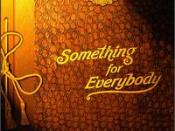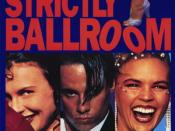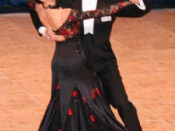Melissa Leung
Question: What does the composer of your text reveal about the concept of belonging? You should answer on either 'Romulus, My Father' or 'Strictly Ballroom' depending on which you have studied. How does he represent his idea? In your answer you may consider literary techniques such as narrative voice, imagery, contrast, hyperbole, word choice, use of setting, description ('Romulus, My Father') or filmic techniques, music, iconography, costuming, dialogue, contrasts, hyperbole ('Strictly Ballroom').
Certain texts raise certain perspectives about belonging, whether it is belonging to particular groups through conformity to rules, or belong to a place where you find inspiration to express your own sense of individuality. The film 'Strictly Ballroom', directed by Baz Luhrmann successfully highlights the true sense of belonging through the use of music, dialogue, lighting and symbolism.
Belonging has been defined as 'a relationship or affinity with something or someone.'
Belonging means to be usually or rightly placed, to have the proper social qualification. Most people have a feeling of connection with particular things, people, places, ideas or beliefs. But some people choose to not belong, that leads to being alienated or excluded from a group.
In particular groups or sub groups within society, there are rules that are other written or simply know by members of the group. Usually, it is accepted that to be a member of these particular groups, you will adhere to the rule, in other words, you will conform. You must do this in order to being. Individuals who challenge these rules and fail to conform are generally dealt with in two ways - They are in danger of becoming alienated from the group or the group might accept the changes and broaden their rules.
The purpose of Baz Luhrmann's film 'Strictly Ballroom' is to explore the ways individuals find their own way of expressing themselves so that they can find their own identity. There is a strong sense that the film's belonging to Australians. The plot makes use of well-known culture and narrative structures to give the audience a sense of place and belonging in the story. The film plays with stereotypes, Australian images and landscapes, mixes genres and fairy-tale story.
At the opening scenes of Strictly Ballroom highlights a fantasy world, the red curtain and the music "Blue Danube" and the back-lit silhouettes reflect the ballroom dancing world. It is a world the audience is set up to admire. Then shattered by the reality - 'C'mon number 100.'The crosscutting to the interviews at the beginning of the film surprises the audience, sending up the content of the interview and the exaggerated seriousness of the characters' approach to ballroom dancing. The interviews describe the events of the recent Southern District Waratah Championships, where Scott Hastings dared to express his individuality through 'non-federation' dance steps. The over-the-top comments of Shirley 'did I fail him as a mother?' create the satirical mockumentary tone. The word 'tragedy' makes the audience laugh at her exaggeration. The number and colours in this scene are symbolic, gold and number 100 represent Scott as the best. Ken Railings is in white which represent purity, but it comes to represent the fakeness of the Ballroom world, and the number 69 alludes to: he is a sleazy customer.
The first time we see Scott alone, he dilemma is represented through dance. He's dancing by himself, but he moves in and out of the spotlight, represents his inner struggle between the desire to conform and belong in the ballroom dancing world, as against has desire for individuality. When Fran confronts Scott with her proposal, she's representing as the outsider in this glitzy world through her unkempt hair, glasses, pimply complexion and over-sized doggy clothing. Scott shows his unwilling attitudes to Fran through a formal tone 'A beginner has no right to approach an open amateur. The close up of Fran challenge our reluctant hero to cross the threshold and begin her journey. She calls him 'scared' and 'just like the rest of them' emphasis a challenge to his sense of individuality. Luhrmann's scene construction also points to her ostracism. The use of mirrors reflect intensifies and we always see Scott in two shots, juxtaposed with Fran on her own. At the end of the scene, we can see that Fran doesn't belong in the ballroom dancing world - her outlook, the way others treated her, dancing with a female partner and having a different background.
In the next scene, Luhrmann approaches an allusion of the story 'Ugly Duckling' to represent Fran is growing connection with Scott. Fran's clothes become tighter; her face clears up, removes her glasses and let her hair down. The background and setting are showing the clash of two cultures. The neon symbolic Coca-Cola sign representing the new and the natural Hills Hoist clothesline representing the traditional of Australia. The music 'Time after Time' and the symbol of sunset signifying the developing connection and establishing a sense of belonging between Scott and Fran. Also, in this scene, the cut-off technique from the roof-top through the building to Doug's dancing in the studio. The music of Doug's dancing is primitive and tribal, a rhythmic percussion which contrasts with the music on the rooftop. Following by a philosophy 'A life lived in fear is a life half lived', it represents the sense of reality and Scott is entering Fran's world. This is the end of Scott teaching Fran, then Scott learning from Fran and family.
At the State Championships, Barry Fife represents the powers that be in the conformist world of the Dance Federation. 'You don't play the games; you don't make the rules.' All such rules suppress originally and individuality, the rules are designed for people to conform. The use of low key lighting is to depict him as evil, shady character. Barry is projected as a bully of the 1950's and dominates the whole Ballroom Dancing World. In the next scene, the music, "Perhaps, Perhaps, Perhaps" signalling a mood change. Two types of scene interact and juxtapose to provide a contrast of the sheer romance and bravery of Scott and Fan dancing against those around them, Shirley, Doug, Barry and Liz. Fran's eye level of the three women surround her standing gives them the appearance of powers over her as they bully her.
To depict the backyard of Fran's house, Luhrmann uses low-key lighting and creates a romantic, warm and inviting atmosphere. When Rico challenges Scott to dance the Paso Doble, Scott is ridiculed for not dancing from the heart and this separates him from the group. Close-ups of people laughing are juxtaposed with long shots of Fran and Scott dancing, showing that they are laughing at the way he dances. The close-up on Rico's feet make Scott realises how insignificant his attempt is. At the end of the scene, a close-up of Scott's face show his sense of enlightenment and desire to connect with the values of Spanish community. Fran is happy for his liberation and newfound sense of belonging. Thus, we can see that Australia is changing from 1950s to a modern and multicultural world.
In the scene - The Hasting's Home, Luhrmann creates a contrast of the world which Scott lives and Fran's world. When Scott is at home or studio or involve in ballroom dancing competition, mockumentary style is used to present an over exaggerated world. Luhrmann is making fun of this particular sub group. In contrast, the scene showing Fran at home with her family are in a naturalistic style. We can see Scott is being more alienated from his family and the ballroom dancing community. On the other hand, Scott is getting accepted by Fran's family, he feels more likely to belong in there. Later on, in the next scene, when Barry confronting Scott, Luhrmann deliberately uses the red curtain again to signifies the theatricality of the dance world. At the end of the scene, Scott is spinning, it is a technique which provides a segue into the next scene. This also indicates he has a lot in his head, should he listen to Barry and conform, or should he be individual and dance with Fran.
In the end of the movie, Fran once shows again she doesn't belong in the ballroom dancing world, she is back to beginner. When Scott tries to explain everything to Fran what's happening, Fran calls Scott 'A gutless wonder' again, this is repetition to show how she feels about Scott. We can see how Fran didn't belong before she asks Scott to dance with her, 'Wash the coffee cups, Fran. How's your skin, Fran?' Everyone didn't accept her to be part of the ballroom community.
'We had the chance, but we were scared, we walked away, we lived our lives in fear!' As Doug screams out, Scott hesitates, he remembers how Fran told him about the 'A life lived in fear is a life half lived.' So he decides to follow his dream, he put on the Spanish costume jacket of the matador, this shows he is belong to Fran's family. When the music is cut-off, the sound of Doug's clapping is heightened by the silence of the room. Scott and Fran continue to dance; nothing can stop them from then. The music, "Love is in the Air" begins, and everyone join in the dance floor, this is a sign of Scott has win; the Ballroom Dancing World has accept him and Fran. And as Barry is falling behind with his trophies emphasis he has been defeated, he can't control the Federation anymore. Then, the red curtain closes meaning show is over.
In conclusion, 'Strictly Ballroom' has showed the concept of belonging through the filmic techniques, storyline and the creation of characters. People often are reluctant to challenge the 'safe world' that they live in, because they fear rejection or becoming cut-off or being alienated. 'Strictly Ballroom' clearly is one of the idea about belonging and not belonging which is explored by Baz Luhrmann.


